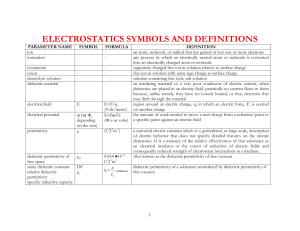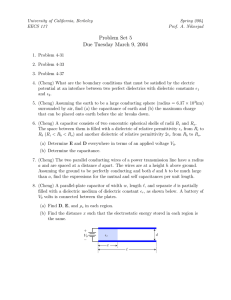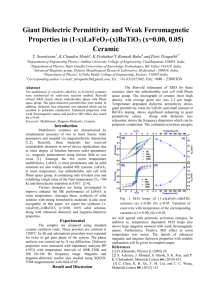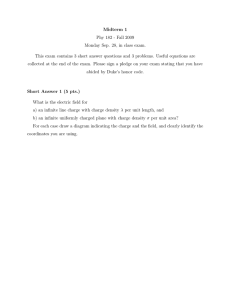Hypersonic and dielectric anomalies of Nb single crystal Pb
advertisement
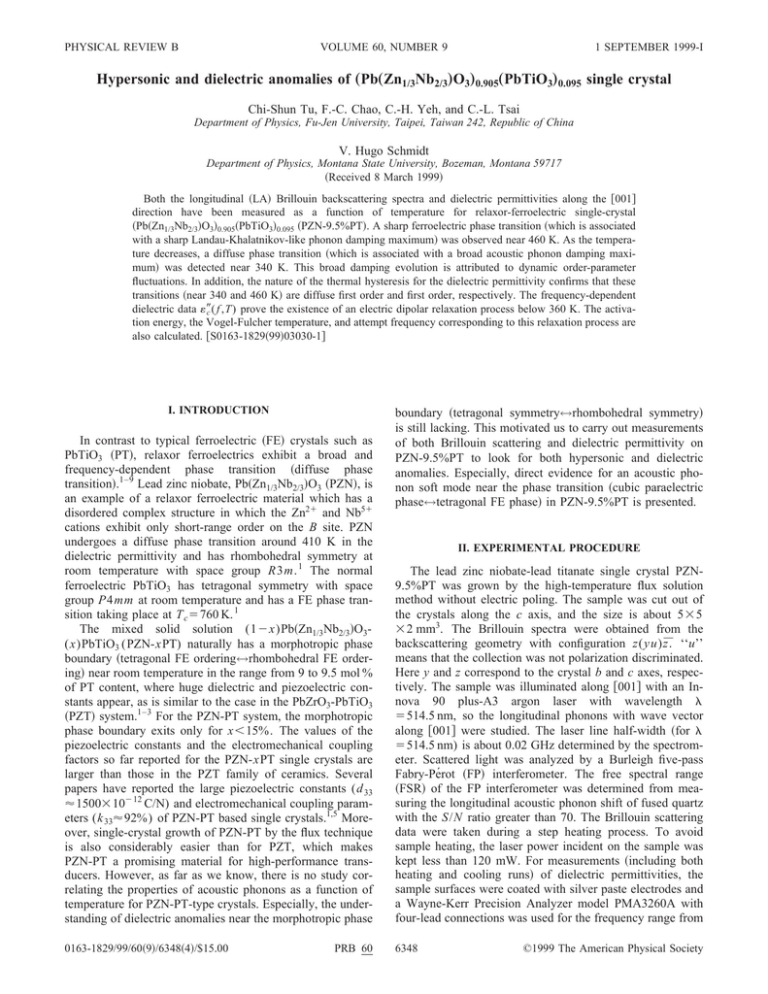
PHYSICAL REVIEW B VOLUME 60, NUMBER 9 1 SEPTEMBER 1999-I Hypersonic and dielectric anomalies of „Pb„Zn1/3Nb2/3…O3…0.905„PbTiO3…0.095 single crystal Chi-Shun Tu, F.-C. Chao, C.-H. Yeh, and C.-L. Tsai Department of Physics, Fu-Jen University, Taipei, Taiwan 242, Republic of China V. Hugo Schmidt Department of Physics, Montana State University, Bozeman, Montana 59717 共Received 8 March 1999兲 Both the longitudinal 共LA兲 Brillouin backscattering spectra and dielectric permittivities along the 关001兴 direction have been measured as a function of temperature for relaxor-ferroelectric single-crystal 共Pb共Zn1/3Nb2/3兲O3兲0.905共PbTiO3兲0.095 共PZN-9.5%PT兲. A sharp ferroelectric phase transition 共which is associated with a sharp Landau-Khalatnikov-like phonon damping maximum兲 was observed near 460 K. As the temperature decreases, a diffuse phase transition 共which is associated with a broad acoustic phonon damping maximum兲 was detected near 340 K. This broad damping evolution is attributed to dynamic order-parameter fluctuations. In addition, the nature of the thermal hysteresis for the dielectric permittivity confirms that these transitions 共near 340 and 460 K兲 are diffuse first order and first order, respectively. The frequency-dependent dielectric data ⬙c ( f ,T) prove the existence of an electric dipolar relaxation process below 360 K. The activation energy, the Vogel-Fulcher temperature, and attempt frequency corresponding to this relaxation process are also calculated. 关S0163-1829共99兲03030-1兴 I. INTRODUCTION In contrast to typical ferroelectric 共FE兲 crystals such as PbTiO3 共PT兲, relaxor ferroelectrics exhibit a broad and frequency-dependent phase transition 共diffuse phase transition兲.1–9 Lead zinc niobate, Pb共Zn1/3Nb2/3兲O3 共PZN兲, is an example of a relaxor ferroelectric material which has a disordered complex structure in which the Zn2⫹ and Nb5⫹ cations exhibit only short-range order on the B site. PZN undergoes a diffuse phase transition around 410 K in the dielectric permittivity and has rhombohedral symmetry at room temperature with space group R3m. 1 The normal ferroelectric PbTiO3 has tetragonal symmetry with space group P4mm at room temperature and has a FE phase transition taking place at T c ⫽760 K. 1 The mixed solid solution (1⫺x)Pb共Zn1/3Nb2/3兲O3(x)PbTiO3 (PZN-xPT) naturally has a morphotropic phase boundary 共tetragonal FE ordering↔rhombohedral FE ordering兲 near room temperature in the range from 9 to 9.5 mol % of PT content, where huge dielectric and piezoelectric constants appear, as is similar to the case in the PbZrO3-PbTiO3 共PZT兲 system.1–3 For the PZN-PT system, the morphotropic phase boundary exits only for x⬍15%. The values of the piezoelectric constants and the electromechanical coupling factors so far reported for the PZN-xPT single crystals are larger than those in the PZT family of ceramics. Several papers have reported the large piezoelectric constants (d 33 ⬇1500⫻10⫺12 C/N) and electromechanical coupling parameters (k 33⬇92%) of PZN-PT based single crystals.1,5 Moreover, single-crystal growth of PZN-PT by the flux technique is also considerably easier than for PZT, which makes PZN-PT a promising material for high-performance transducers. However, as far as we know, there is no study correlating the properties of acoustic phonons as a function of temperature for PZN-PT-type crystals. Especially, the understanding of dielectric anomalies near the morphotropic phase 0163-1829/99/60共9兲/6348共4兲/$15.00 PRB 60 boundary 共tetragonal symmetry↔rhombohedral symmetry兲 is still lacking. This motivated us to carry out measurements of both Brillouin scattering and dielectric permittivity on PZN-9.5%PT to look for both hypersonic and dielectric anomalies. Especially, direct evidence for an acoustic phonon soft mode near the phase transition 共cubic paraelectric phase↔tetragonal FE phase兲 in PZN-9.5%PT is presented. II. EXPERIMENTAL PROCEDURE The lead zinc niobate-lead titanate single crystal PZN9.5%PT was grown by the high-temperature flux solution method without electric poling. The sample was cut out of the crystals along the c axis, and the size is about 5⫻5 ⫻2 mm3. The Brillouin spectra were obtained from the backscattering geometry with configuration z(yu)z̄. ‘‘u’’ means that the collection was not polarization discriminated. Here y and z correspond to the crystal b and c axes, respectively. The sample was illuminated along 关001兴 with an Innova 90 plus-A3 argon laser with wavelength ⫽514.5 nm, so the longitudinal phonons with wave vector along 关001兴 were studied. The laser line half-width 共for ⫽514.5 nm) is about 0.02 GHz determined by the spectrometer. Scattered light was analyzed by a Burleigh five-pass Fabry-Pérot 共FP兲 interferometer. The free spectral range 共FSR兲 of the FP interferometer was determined from measuring the longitudinal acoustic phonon shift of fused quartz with the S/N ratio greater than 70. The Brillouin scattering data were taken during a step heating process. To avoid sample heating, the laser power incident on the sample was kept less than 120 mW. For measurements 共including both heating and cooling runs兲 of dielectric permittivities, the sample surfaces were coated with silver paste electrodes and a Wayne-Kerr Precision Analyzer model PMA3260A with four-lead connections was used for the frequency range from 6348 ©1999 The American Physical Society PRB 60 HYPERSONIC AND DIELECTRIC ANOMALIES OF . . . 6349 FIG. 1. Stokes components of the LA关001兴 Brillouin scattering spectra for PZN-9.5%PT. The solid lines are fits to the damped harmonic oscillator model. 300 Hz to 2.5 MHz. A Janis model CCS-450 closed-cycle refrigerator 共which is designed for the temperature range 10– 475 K兲 was used with a Lakeshore model 340 temperature controller for both of the above temperature-dependent measurements. III. RESULTS AND DISCUSSION Actual temperature-dependent LA关001兴 phonon spectra of the Stokes Brillouin component are shown in Fig. 1. The solid lines are fits to the damped harmonic oscillator model,10 from which the frequency shift and half-width 共damping兲 were obtained. The phonon frequency exhibits a strong negative coupling 共softening兲 near 460 K. Figure 2共a兲–2共c兲 show the temperature dependences 共heating run兲 of the phonon frequency shift, half-width, and the real part c⬘ of dielectric permittivity, respectively. Due to the weak intensity factor 共the S/N ratio of Brillouin scattering spectra is about 2 for PZN-9.5%PT兲 and the uncertainty of the collection angle which can appreciably broaden and distort the Brillouin line shape, the frequency shift and half-width data 关Figs. 2共a兲 and 2共b兲兴 show scatter. The phonon frequency shows two successive minimum dips near 340 and 460 K 共which is more pronounced with a reduction about 5%兲, associated with a strong broad damping peak and a sharp damping peak, respectively. Figures 3共a兲 and 3共b兲 show the temperature dependences of both the real and imaginary parts ( c⬘ and c⬙ ) of the dielectric permittivity for the frequency range from 300 Hz to 2.5 MHz upon cooling. The insets of Fig. 3 are enlargements of both c⬘ and ⬙c for temperatures below 450 K to clarify the dispersion behavior. Compared with the prototypical relaxor ferroelectric crystal Pb共Zn1/3Nb2/3兲O3, which has a dif- FIG. 2. 共a兲 Brillouin frequency shift 共open circles兲, 共b兲 halfwidth 共solid circles兲, and 共c兲 the real part c⬘ of dielectric permittivity 共heating run兲 vs temperature for PZN-9.5%PT. The dashed lines are guides for the eye. fuse phase transition near 410 K, PZN-9.5%PT exhibits a much narrower frequency dispersion and weaker maximum of dielectric constant near 460 K due to the PT content. For temperature below 360 K, a broad dispersion anomaly 共with much weaker dielectric constant兲 appears in both ⬘c and c⬙ . Figure 4 shows the temperature-dependent data of ⬘c from both cooling and heating runs at measuring frequency f ⫽50 kHz. Two clear thermal hystereses were observed near 300⫾40 and 455⫾5 K, respectively. The inset of Fig. 4 shows the reciprocal of ⬘c in which a typical first-order-type FE phase transition appears near 460 K.11 What are the origins of the temperature-dependent Brillouin spectra and dielectric phenomena shown in Figs. 2–4 for PZN-9.5%PT near 460 K? For a typical FE phase transition, the transition temperature occurs where the frequency shift curve of acoustic phonon has an abrupt change.11,12 In PZN-9.5%PT, the acoustic phonon frequency 关Fig. 2共a兲兴 reaches a sharp turning point near 460 K. The real part c⬘ of dielectric permittivity 关Fig. 2共c兲兴 exhibits a steep change 共with narrow frequency dispersion兲 and an obvious thermal hysteresis near 460 K. In addition, a sharp damping maximum 关Fig. 2共b兲兴, which is associated with a LandauKhalatnikov-like maximum, was detected near 460 K. Such a damping anomaly is usually attributed to a rapid growth of long-range electric ordering. Thus we conclude that the PZN-9.5%PT single crystal possesses a sharp first-order ferroelectric phase transition at T c ⬇460 K. This value is consistent with the transition temperature 460⫾5 K 共cubic paraelectric phase↔tetragonal FE phase兲 predicated from the 6350 TU, CHAO, YEH, TSAI, AND SCHMIDT PRB 60 FIG. 4. Thermal hysteresis of the real part ⬘c ( f ,T) of the dielectric permittivity taken at measuring frequency f ⫽50 kHz. The inset is the reciprocal of c⬘ . FIG. 3. Temperature dependences of 共a兲 the real part ⬘c and 共b兲 the imaginary part c⬙ of the dielectric permittivity for PZN9.5%PT, taken from frequencies from 300 Hz to 2.5 MHz upon cooling (cooling rate⫽1.5 K/min). The insets are enlargements for both 共a兲 c⬘ and 共b兲 c⬙ below 450 K. morphotropic phase boundary 共MPB兲 in Ref. 1. Ferroelectric transitions are known to be associated with a soft mode of lattice motion. Lines and Glass pointed out that if the transition is strongly first order, mode softening may not be detectable.11 Thus, with the temperature-dependent dielectric results, the phase transition near 460 K 共paraelectric phase↔FE phase兲 for PZN-9.5%PT should be weakly first order. We note that a zone-center (q⫽0) acoustic soft mode in the reduced Brillouin zone of the reciprocal sublattice always has, for a second-order transition, a zero frequency on approaching T c from the ordered phase, i.e., T ˜T ⫺ c . Therefore, the nonzero minimum of phonon frequency shift at ⬇460 K implies either a first-order transition or that the structural instabilities 共as T˜T ⫹ c ) in PZN9.5%PT must be associated with a more complicated mode. In the lower-temperature region 共below 360 K兲, the acoustic phonon frequency 关Fig. 2共a兲兴 reaches a weak turning point near 340 K. The real part ⬘c of dielectric permittivity 关Figs. 2共c兲 and 3兴 exhibits a gradual change with a notably extensive frequency dispersion 共or diffuse phase transition兲 and an obvious thermal hysteresis near 340 K. Correspondingly, the imaginary part c⬙ of dielectric permittivity also shows a relatively pronounced frequency dispersion. Instead of a sharp maximum 共near 460 K兲, the acoustic phonon damping 关Fig. 2共b兲兴 of PZN-9.5%PT exhibits a gradual growth with a maximum located near 340 K. Such a slowly rising damping anomaly reveals that order-parameter fluctuations are the dominant dynamic mechanism. Qualitative estimates of this fluctuation contribution are given by the dashed curve in Fig. 2共b兲. The dynamic fluctuation contribution is a characteristic of an 2 -type electrostrictive coupling, squared in order parameter and linear in strain.12 A similar acoustic damping anomaly was also seen in other mixed systems such as Pb共Mg1/3Nb2/3兲O3 共PMN兲 and Rb1⫺x (ND4) x D2AsO4 (DRADA-x) in which a local shortrange order or a coexistence of two different phases was found.12,13 According to previous x-ray diffraction 共XRD兲 data, the PZN-10%PT crystal possesses a mixed phase of rhombohedral and tetragonal symmetries around the morphotropic phase boundary.1 Thus one can conclude that the PZN-9.5%PT composition has a diffuse transition near 340 K which is triggered by the local structural fluctuation between rhombohedral and tetragonal symmetries. We call this a first-order transition only because the thermal hysteresis in the permittivity shows that the system is metastable in this temperature region. The usual distinctions between first- and second-order transitions, such as discontinuity in d P/dT, do not apply for diffuse transitions. In addition to the acoustic anomalies near 340 K, there is another similar frequency shift dip near 410 K with a corresponding damping maximum 共Fig. 2兲. The imaginary part c⬙ of dielectric permittivity also shows a frequency dispersion which is relatively weaker than that which appears below 360 K 关inset of Fig. 3共b兲兴. These occur close to the diffused phase transition temperature of pure PZN.1 These anomalies 共near 410 K兲 could be due to unmixed regions of pure PZN within the sample. Precise measurements at temperatures below 360 K proved the existence of frequency dispersion in both the real c⬘ ( f ,T) and imaginary c⬙ ( f ,T) parts of the dielectric permittivity, which are illustrated in the insets of Figs. 3共a兲 and 3共b兲, respectively. These dispersion phenomena of both ⬘c and c⬙ confirm that the relaxation process begins to be evidenced below 360 K. As shown in Fig. 5, it was found that PRB 60 HYPERSONIC AND DIELECTRIC ANOMALIES OF . . . 6351 usual range for lattice vibration frequency. Second, E a is an average activation energy for various clusters in this partly disordered system to reorient, perhaps between rhombohedral and tetragonal local symmetries. Third, T 0 is the temperature at which, based on an unjustified extrapolation of the Vogel-Fulcher formula beyond the range of the data, all reorientation would cease. The fact that the Vogel-Fulcher formula fits better than the Arrhenius formula for many disordered systems reflects the fact that, as temperature decreases, a greater number of cooperative steps must occur in the course of a typical reorientation event. IV. CONCLUSIONS FIG. 5. ln(f ) vs 1000/T. f is the measuring frequency and T is the temperature corresponding to the maximum value of ⬙c below 360 K. The solid line is the fit of Eq. 共1兲 with the parameters mentioned in the text. the relaxation occurring in the temperature region 共100–360 K兲 obeys the exponential Vogel-Fulcher equation that has been used to describe other relaxation process, especially for mixed systems: f ⫽ f 0 e ⫺E a /k B 共 T g ⫺T 0 兲 , 共1兲 where f is the measured frequency, f 0 is the attempt frequency, and E a is the activation energy for orientation of electric dipoles. T 0 is the Vogel-Fulcher temperature, and T g is the temperature where the imaginary part c⬙ of the dielectric permittivity reaches its maximum value. The results of the activation energy, attempt frequency, and Vogel-Fulcher temperature for PZN-9.5%PT are E a ⬇125 meV(1446 K), f 0 ⬇1.4⫻1013 Hz, and T 0 ⬇191 K. What is the significance of these parameters? First, the attempt frequency is in the 1 M. L. Mulvihill, S. E. Park, G. Risch, Z. Li, and K. Uchino, Jpn. J. Appl. Phys., Part 1 35, 3984 共1996兲. 2 J. Kuwata, K. Uchino, and S. Nomura, Ferroelectrics 37, 579 共1981兲. 3 J. Kuwata, K. Uchino, and S. Nomura, Jpn. J. Appl. Phys., Part 1 21, 1298 共1982兲. 4 S. Nomura, H. Arima, and F. Kojima, Jpn. J. Appl. Phys. 12, 531 共1973兲. 5 Y. Yamashita, Jpn. J. Appl. Phys., Part 1 33, 5328 共1994兲. 6 S. E. Park, M. L. Mulvihill, G. Risch, and T. R. Shrout, Jpn. J. Appl. Phys., Part 1 36, 1154 共1996兲. 7 S.-E. Paek and T. R. Shrout, J. Appl. Phys. 82, 1804 共1997兲. From the temperature-dependent Brillouin scattering LA关001兴 spectra and dielectric permittivities ( ⬘c and ⬙c ) of PZN-9.5%PT, two successive phase transitions are evidenced near 460 K 共cubic paraelectric phase↔tetragonal ferroelectric phase兲 and 340 K 共a diffuse phase transition兲, respectively. A broad acoustic phonon damping evolution and a sharp Landau-Khalatnikov-like damping maximum were observed correspondingly. These two hypersonic damping anomalies imply that a diffuse phase transition 共which is associated with a coexistence of both tetragonal and rhombohedral symmetries兲 and a rapid growth of FE ordering take place near 340 and 460 K, respectively. The behaviors of dielectric permittivity thermal hysteresis confirm that both phase transitions are first order. The frequency-dependent dielectric data c⬙ ( f ,T) of PZN9.5%PT proved the existence of an electric dipolar relaxation process below 360 K. The activation energy, Vogel-Fulcher temperature, and attempt frequency corresponding to this relaxation process are also calculated. ACKNOWLEDGMENTS The authors would like to express sincere thanks to L.-F. Chen for help on experiments. This work was supported by NSC88-2112-M-030-002 共R.O.C.兲, NSF Grant No. DMR9805272, and DOD EPSCOR Grant No. N00014-99-1-0523. 8 S. Nomura, T. Takahashi, and Y. Yokomizo, J. Phys. Soc. Jpn. 27, 262 共1969兲. 9 J. Kuwata, K. Uchino, and S. Nomura, Ferroelectrics 37, 579 共1981兲. 10 C.-S. Tu, R. S. Katiyar, V. H. Schmidt, R. Guo, and B. S. Bhalla, Phys. Rev. B 59, 251 共1999兲. 11 M. E. Lines and A. M. Glass, Principles and Applications of Ferroelectrics and Related Materials 共Oxford University Press, London, 1977兲. 12 C.-S. Tu and V. H. Schmidt, Phys. Rev. B 50, 16 167 共1994兲. 13 C.-S. Tu, V. H. Schmidt, and I. G. Siny, J. Appl. Phys. 78, 5665 共1995兲.

